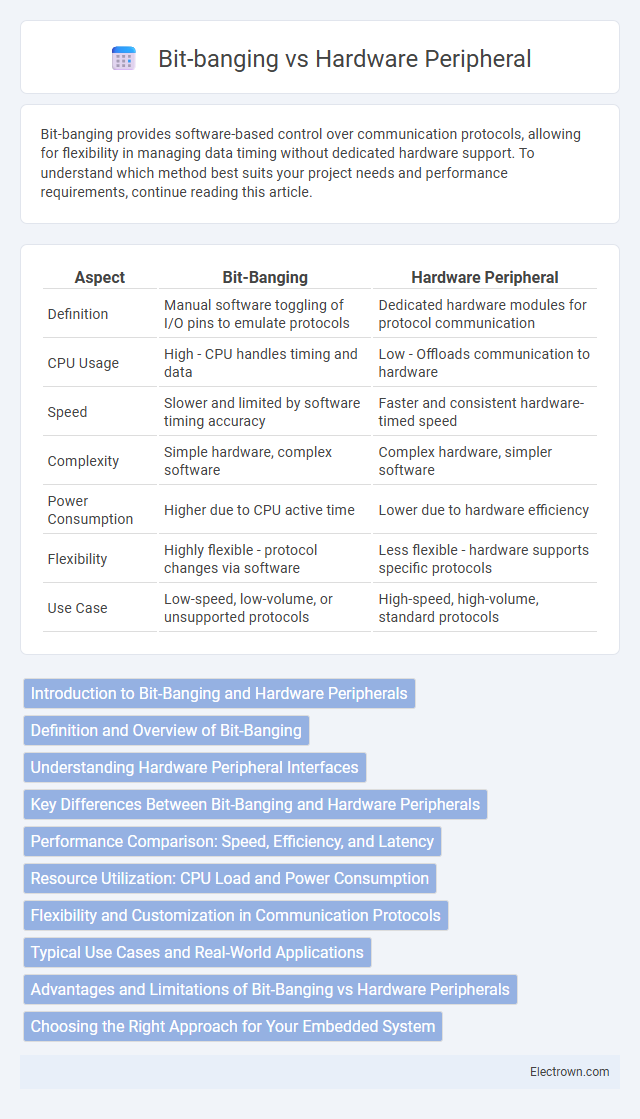Bit-banging provides software-based control over communication protocols, allowing for flexibility in managing data timing without dedicated hardware support. To understand which method best suits your project needs and performance requirements, continue reading this article.
Table of Comparison
| Aspect | Bit-Banging | Hardware Peripheral |
|---|---|---|
| Definition | Manual software toggling of I/O pins to emulate protocols | Dedicated hardware modules for protocol communication |
| CPU Usage | High - CPU handles timing and data | Low - Offloads communication to hardware |
| Speed | Slower and limited by software timing accuracy | Faster and consistent hardware-timed speed |
| Complexity | Simple hardware, complex software | Complex hardware, simpler software |
| Power Consumption | Higher due to CPU active time | Lower due to hardware efficiency |
| Flexibility | Highly flexible - protocol changes via software | Less flexible - hardware supports specific protocols |
| Use Case | Low-speed, low-volume, or unsupported protocols | High-speed, high-volume, standard protocols |
Introduction to Bit-Banging and Hardware Peripherals
Bit-banging is a software-driven technique for serial communication where microcontroller pins are manually toggled to simulate hardware protocols like SPI or I2C, offering flexibility at the cost of higher CPU usage. Hardware peripherals are dedicated modules within microcontrollers designed to handle communication protocols efficiently with minimal CPU intervention, ensuring faster data transfer and lower power consumption. Comparing bit-banging and hardware peripherals highlights trade-offs between simplicity and performance in embedded system design.
Definition and Overview of Bit-Banging
Bit-banging is a technique in embedded systems and microcontroller programming where software directly controls the timing and state of I/O pins to simulate communication protocols without dedicated hardware support. Unlike hardware peripherals that manage data transmission autonomously through specialized registers and logic, bit-banging relies entirely on CPU cycles to generate signals, often resulting in higher CPU overhead and less precise timing. This method offers flexibility for custom or unsupported protocols but may sacrifice performance compared to hardware-driven communication interfaces such as SPI, I2C, or UART modules.
Understanding Hardware Peripheral Interfaces
Hardware peripheral interfaces offer precise timing and efficient data transfer by utilizing dedicated circuitry, minimizing CPU involvement compared to bit-banging techniques that rely on software-driven signal manipulation. Your system's performance and reliability improve significantly when hardware peripherals handle communication protocols such as SPI, I2C, or UART, ensuring consistent timing and reducing processor load. Understanding the trade-offs and capabilities of hardware peripherals helps optimize embedded system designs and resource allocation.
Key Differences Between Bit-Banging and Hardware Peripherals
Bit-banging involves software-driven control of communication protocols using general-purpose I/O pins, while hardware peripherals manage data transfer through dedicated integrated circuits, offering higher speed and efficiency. Hardware peripherals reduce CPU load by handling timing and signal generation internally, whereas bit-banging demands precise timing from your processor, potentially impacting system performance. Understanding these differences is crucial for optimizing communication reliability and resource allocation in embedded system design.
Performance Comparison: Speed, Efficiency, and Latency
Hardware peripherals outperform bit-banging techniques in speed and efficiency by handling data transfers with dedicated circuitry, resulting in faster and more consistent communication. Bit-banging relies on CPU cycles for signal timing, causing higher latency and increased processor load, which reduces overall system performance. Optimizing embedded applications demands leveraging hardware peripherals to minimize CPU intervention, ensuring lower latency and higher throughput.
Resource Utilization: CPU Load and Power Consumption
Bit-banging consumes significant CPU resources by requiring the processor to handle every signal transition manually, leading to increased CPU load and higher power consumption. Hardware peripherals offload timing-critical communication to dedicated modules, freeing the CPU for other tasks and reducing overall energy usage. This distinction makes hardware peripherals more efficient in resource utilization, especially in power-sensitive and real-time applications.
Flexibility and Customization in Communication Protocols
Bit-banging offers unparalleled flexibility and customization by allowing you to implement any communication protocol through software control, enabling tailored timing and signal manipulation without hardware constraints. Hardware peripherals, while providing faster and more reliable communication due to dedicated circuitry, are limited to pre-defined protocols and fixed functionalities. For projects requiring unique or evolving protocol designs, bit-banging delivers adaptable solutions that hardware modules cannot easily match.
Typical Use Cases and Real-World Applications
Bit-banging is typically used in low-cost or resource-constrained embedded systems where dedicated hardware peripherals are unavailable or insufficient, enabling direct software control of communication protocols like SPI, I2C, and UART. Hardware peripherals excel in real-time, high-speed data transmission applications such as industrial automation, audio processing, and communication devices by offloading tasks from the CPU, increasing efficiency and reliability. Your choice depends on balancing flexibility and timing precision against processing overhead and system complexity in specific real-world scenarios.
Advantages and Limitations of Bit-Banging vs Hardware Peripherals
Bit-banging enables flexible, software-controlled communication protocols without needing specialized hardware peripherals, making it ideal for simple or custom interfaces on microcontrollers lacking built-in modules. However, bit-banging consumes significant CPU cycles and can lead to timing inaccuracies, limiting performance at higher speeds compared to dedicated hardware peripherals designed for precise, efficient data transmission. Your choice depends on balancing ease of implementation and resource availability against the need for reliable, high-speed communication in your embedded system.
Choosing the Right Approach for Your Embedded System
Bit-banging offers flexibility and cost savings by using software to control GPIO pins for serial communication, ideal for simple or low-speed tasks without dedicated hardware. Hardware peripherals provide reliable, efficient, and faster data transfer with lower CPU load, making them suitable for complex or high-speed applications in embedded systems. Evaluating your system's performance requirements, power consumption, and resource availability helps determine whether bit-banging or a hardware peripheral is the optimal choice.
Bit-banging vs hardware peripheral Infographic

 electrown.com
electrown.com